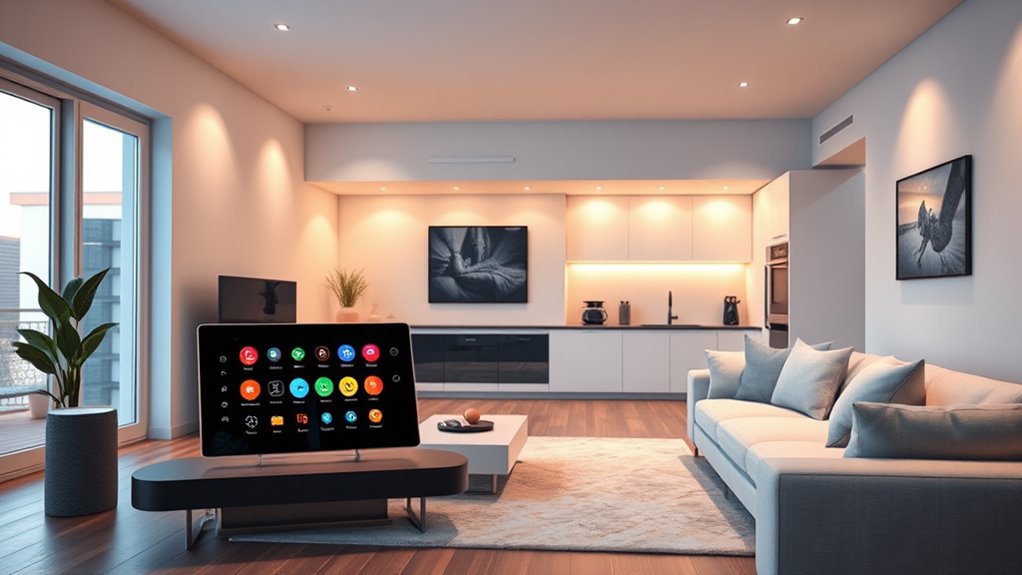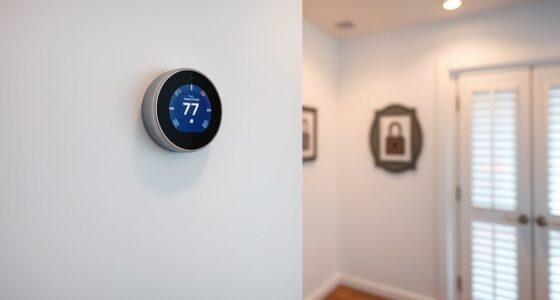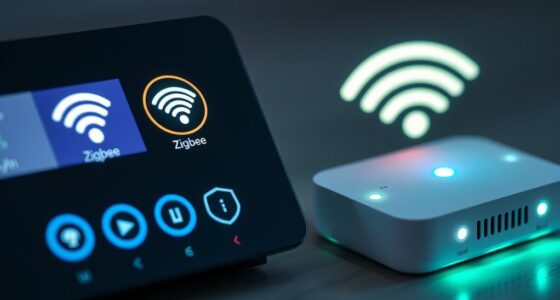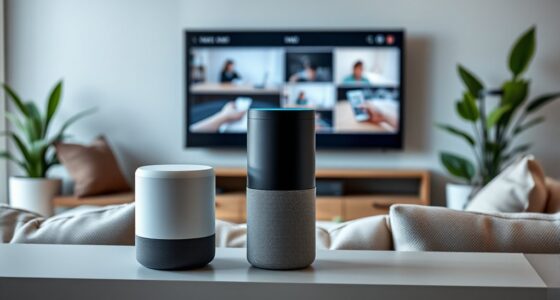Matter protocol acts as the universal standard that simplifies connecting smart home devices across brands and platforms. It focuses on energy efficiency, security, and seamless interoperability, making setup easier and device collaboration smoother. With open-source development, it encourages community-driven innovation and faster updates. This protocol aims to create a more secure, reliable, and energy-conscious smart home environment. To discover how Matter is shaping your connected home, explore more about its core principles and benefits.
Key Takeaways
- Matter is an open-source, standardized protocol designed to enable seamless, secure communication among smart home devices across brands.
- It emphasizes energy efficiency, robust security, and interoperability to simplify device setup and long-term management.
- By fostering community-driven development, Matter accelerates innovation and broadens device compatibility in the smart home ecosystem.
- Its standardized approach reduces vendor lock-in, enhances user experience, and promotes faster deployment of updates and new features.
- Overall, Matter acts as the “glue” that creates a unified, secure, and sustainable smart home environment.
Understanding the Core Principles of Matter Protocol

What exactly are the core principles that define the Matter Protocol? At its heart, Matter emphasizes energy efficiency, helping your smart devices conserve power while maintaining performance. This focus ensures devices operate longer without frequent recharges or replacements. Data encryption is another key principle, securing your smart home by protecting your information from unauthorized access. Matter uses robust encryption methods to keep device communication private and safe, giving you peace of mind. The protocol also promotes interoperability, making sure devices from different brands work seamlessly together. By combining energy efficiency with strong data encryption, Matter creates a unified, secure, and sustainable smart home ecosystem that’s easy to manage and reliable for everyday use. Additionally, the protocol’s emphasis on standardized communication simplifies device setup and integration, reducing compatibility issues.
How Matter Simplifies Device Setup and Installation

Matter makes setting up and installing your smart devices straightforward and hassle-free. With its universal compatibility, you can connect new devices quickly without fuss. The process is simplified, reducing the need for multiple apps or complex configurations. This ease of setup encourages energy efficiency, as devices can be optimized effortlessly for power saving and performance. Plus, user customization is seamless—adjust settings to fit your preferences without technical hurdles. Here’s a quick overview:
| Aspect | Benefit | Impact |
|---|---|---|
| Universal Compatibility | Faster device pairing | Less frustration |
| Automated Setup | Save time during installation | More energy-conscious use |
| User Customization | Personalize device behavior | Enhanced user experience |
| Energy Efficiency | Optimized power management | Lower energy bills |
| Simple Integration | Works across brands and platforms | Smarter, cohesive home |
Additionally, privacy considerations are integral to maintaining user trust and compliance with data protection standards.
Enhancing Security and Privacy in Smart Homes With Matter
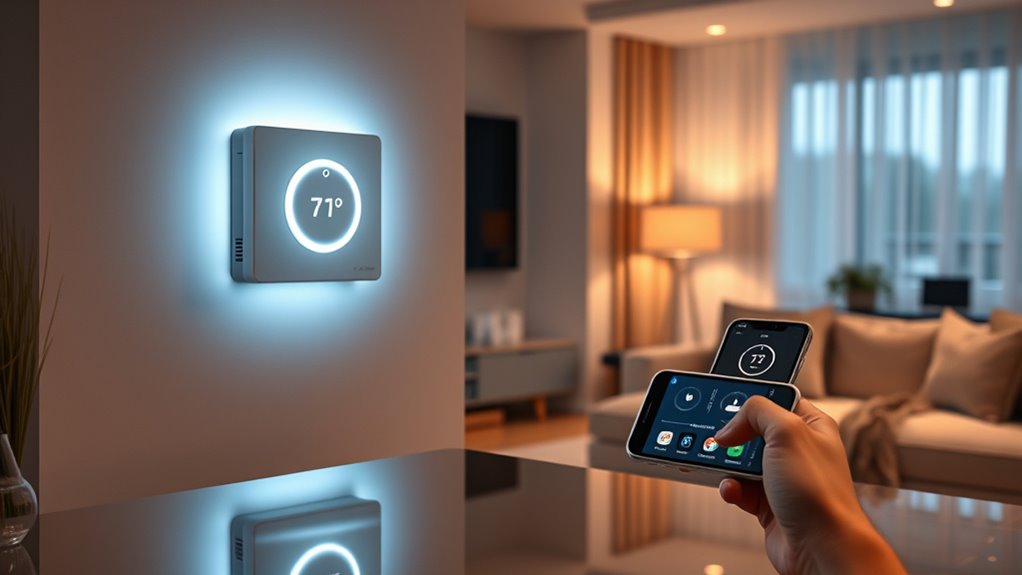
While smart home technology offers convenience and connectivity, safeguarding your privacy and security remains essential. The Matter protocol prioritizes privacy safeguards by design, ensuring your data stays protected. It uses robust data encryption methods to secure communication between devices, making it harder for hackers to intercept or manipulate sensitive information. Additionally, Matter enforces strict authentication processes, verifying device identities before granting access. This layered security approach minimizes vulnerabilities and helps prevent unauthorized control of your smart home. With these measures in place, you can enjoy the benefits of connected devices without worrying about privacy breaches. Overall, Matter’s focus on privacy safeguards and data encryption creates a safer environment, giving you peace of mind as your smart home becomes more integrated and intelligent. Continuous advancements in cybersecurity practices further strengthen the resilience of these protocols against evolving threats.
Compatibility and Interoperability Across Brands and Platforms
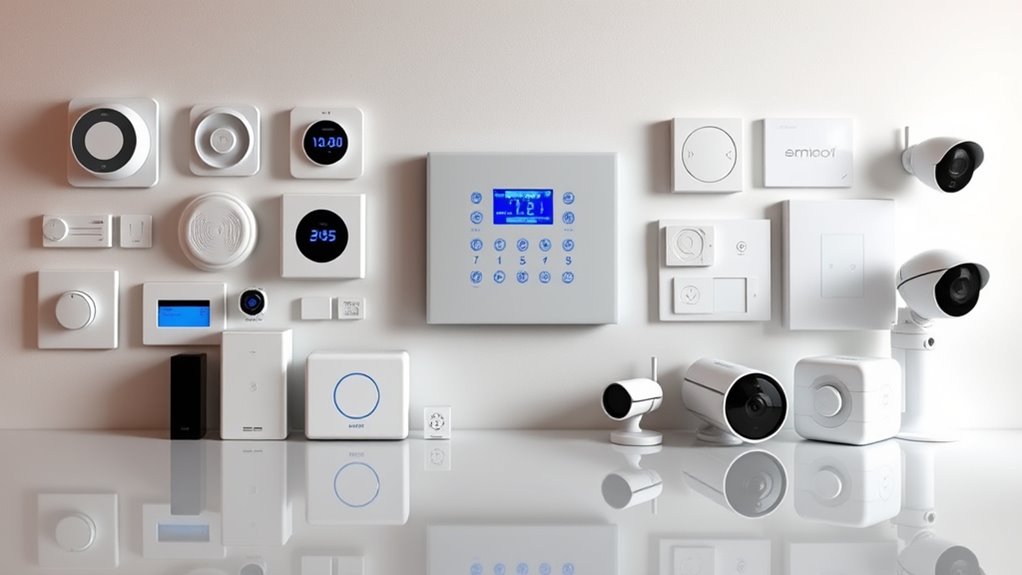
You want your smart devices to work smoothly together, regardless of brand or platform. With Matter, unified device communication makes cross-brand compatibility a reality. This guarantees seamless platform integration, so your smart home functions effortlessly across all devices. Implementing interoperability standards ensures ongoing compatibility and future-proofing your smart home ecosystem.
Unified Device Communication
Achieving seamless device communication across different brands and platforms is essential for creating a unified smart home experience. With Matter, devices can share information effortlessly, regardless of manufacturer. This improves user interaction, ensuring a smooth user interface and consistent control. It also optimizes device energy consumption by enabling coordinated operation, reducing unnecessary power use. To deepen this integration, consider how:
- Devices transmit status updates in real-time, keeping your system synchronized
- Compatibility standards simplify setup, reducing frustration
- Cross-platform control ensures your devices respond uniformly
- Interoperability enhances overall energy efficiency and device longevity
- Incorporating Bedroom design principles can further create a comfortable and harmonious living environment.
Cross-Brand Compatibility
How does Matter guarantee that devices from different brands work seamlessly together? It uses standardized protocols, guaranteeing compatibility across various platforms and manufacturers. This means your smart lights, thermostats, and voice control devices can communicate effortlessly, regardless of brand. Compatibility isn’t just about basic function; it also enhances energy efficiency by enabling coordinated control. For example, a Matter-enabled smart bulb can adjust brightness based on your routines, saving energy. Here’s how compatibility impacts device interaction:
| Feature | Benefit | |
|---|---|---|
| Cross-brand support | Broader device options, less vendor lock-in | |
| Unified control | Simplifies management across devices | |
| Interoperability | Ensures smooth communication and automation | Interoperability standards facilitate this seamless interaction. |
Seamless Platform Integration
Seamless platform integration guarantees that smart devices from different brands and ecosystems work together effortlessly, providing a unified user experience. To achieve this, the Matter protocol simplifies device onboarding, making setup quick and intuitive across platforms. It also enhances network stability, ensuring your smart home remains reliable even as you add new devices. With broad compatibility, you won’t need to worry about brand limitations or multiple apps. Fostering collaboration between developers and cybersecurity experts ensures ongoing security and resilience in smart home ecosystems. – Streamlined device onboarding minimizes setup time – Consistent communication across platforms improves stability – Reduced compatibility issues prevent device conflicts – Simplified updates keep all devices synchronized efficiently
The Role of Open-Source Development in Matter’s Growth
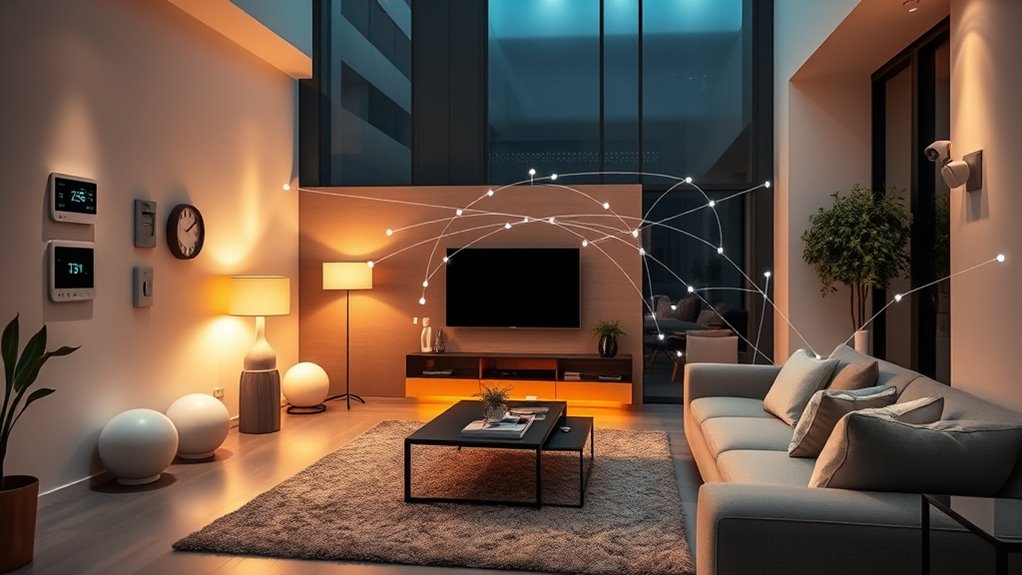
Open-source development fuels Matter’s growth by fostering collaborative innovation that drives progress. When communities actively contribute, protocol adoption becomes more widespread and robust. This open approach also accelerates compatibility across different devices and platforms, making the ecosystem stronger for everyone.
Collaborative Innovation Drives Progress
Have you ever wondered what fuels the rapid growth of Matter? It’s the power of collaborative innovation, driven by open-source development. When manufacturers, developers, and enthusiasts share ideas, they improve device energy efficiency and durability. This shared effort accelerates progress and guarantees compatibility across diverse products. Additionally, best anime movies showcase the importance of diverse perspectives and storytelling, inspiring innovative approaches in technology and design. You benefit from this collective approach through: – Faster identification of issues and fixes – Enhanced device resilience and lifespan – Improved energy management techniques – Greater adaptability to evolving smart-home needs
Community-Driven Protocol Adoption
How does open-source development propel Matter’s rapid adoption and growth? By fostering strong community engagement, open source collaboration accelerates innovation and broadens support for the protocol. When developers, manufacturers, and enthusiasts contribute openly, they share ideas, troubleshoot issues, and improve the standard collaboratively. This collective effort guarantees Matter evolves quickly to meet real-world needs, making it more reliable and versatile. Open-source development also encourages transparency, building trust among stakeholders and driving widespread adoption. As more participants get involved, the community’s feedback shapes the protocol’s future, creating a dynamic ecosystem. Additionally, hybrid bicycles exemplify how versatile and adaptable open-source concepts can be, which parallels the collaborative nature of Matter’s development. Ultimately, this community-driven approach fuels Matter’s growth, making it a truly inclusive, adaptable, and universally embraced smart-home standard.
Open-Source Accelerates Compatibility
By encouraging broad collaboration, open-source development directly enhances Matter’s compatibility across diverse devices and platforms. The open source benefits include faster innovation, shared security improvements, and easier integration for manufacturers. It helps address compatibility challenges by allowing developers to identify and resolve issues quickly, ensuring devices work seamlessly together. Open-source projects foster transparency, enabling you to verify code and trust its security. Additionally, open collaboration encourages diverse contributions, broadening device support and reducing fragmentation. This collective effort accelerates the adoption of new features and standards. As a result, your smart home ecosystem becomes more reliable, flexible, and future-proof, making device interoperability smoother and more consistent for everyone involved. Open‑source development also facilitates the rapid deployment of updates and new functionalities, keeping your devices up-to-date with minimal hassle.
Impact of Matter on Smart Home Ecosystem and User Experience

The adoption of the Matter protocol considerably transforms the smart home ecosystem by promoting seamless device interoperability and simplifying user interactions. With Matter, you can control multiple devices through voice control without juggling different apps or platforms. This unified approach makes managing your smart home more intuitive and responsive. Additionally, Matter enhances energy efficiency by enabling devices to communicate better and coordinate actions, reducing unnecessary power consumption. You’ll notice improvements in automation, such as smarter lighting and climate control, which adapt to your habits. Overall, the protocol streamlines your experience, making smart devices more reliable and easier to use. As a result, your home becomes more convenient, energy-conscious, and future-proof, creating a more integrated and satisfying user experience.
Challenges and Limitations Facing Widespread Adoption
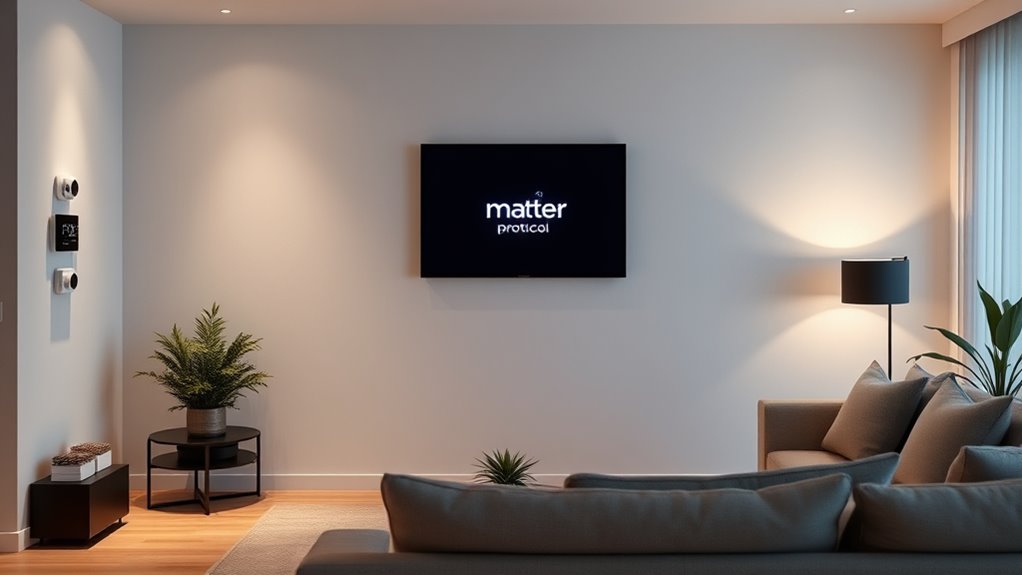
Despite the promising benefits of the Matter protocol, several challenges hinder its widespread adoption. Technical hurdles include ensuring compatibility across diverse devices and ecosystems, which demands extensive testing and updates. Regulatory barriers also present obstacles, as differing standards and certifications across regions slow implementation and increase costs. Additionally, device manufacturers may hesitate to adopt Matter due to concerns about intellectual property and market competition. Market fragmentation and the need for firmware updates can further delay adoption. Privacy and security considerations also pose challenges, requiring robust measures that may complicate deployment. Overcoming these issues requires coordinated efforts among industry players and regulators to streamline technical requirements and harmonize standards. Without addressing these hurdles, full integration of Matter into the smart home landscape remains uncertain.
Future Developments and Innovations Driven by Matter
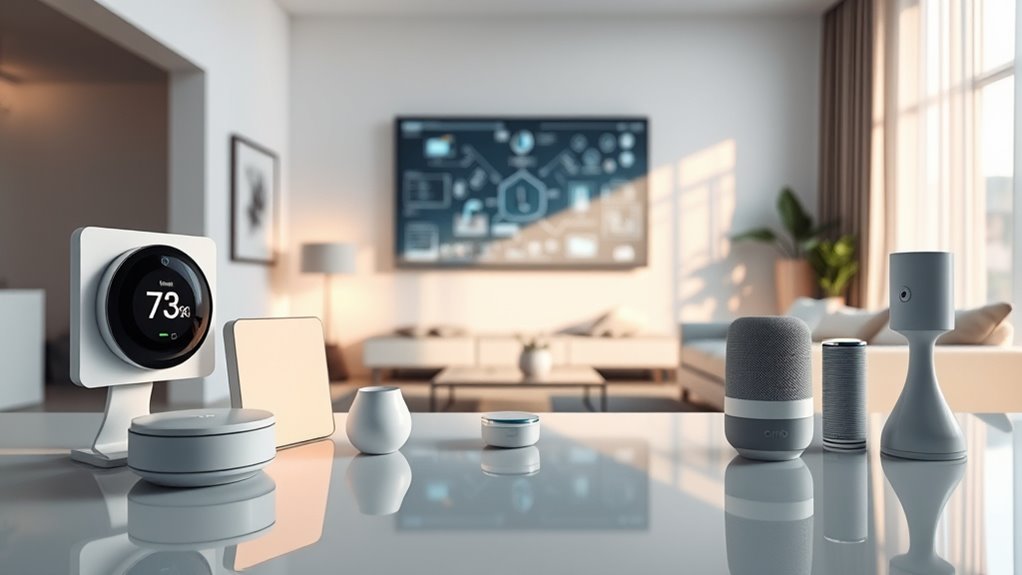
As Matter continues to gain traction, it is poised to drive significant innovations in smart home technology. You can expect enhanced AI integration, allowing devices to learn from your habits and automate routines more intelligently. This will make your smart home more responsive and personalized. Additionally, Matter will promote greater energy efficiency by optimizing device performance and reducing unnecessary power consumption. As manufacturers adopt these advancements, you’ll see smarter thermostats, lighting, and appliances working seamlessly together. These innovations will not only make your home more convenient but also more sustainable. With a unified protocol supporting AI and energy-saving features, the future of smart homes becomes more intelligent, efficient, and user-friendly, ultimately transforming how you interact with your environment.
How Consumers and Manufacturers Can Benefit From the Protocol

Consumers and manufacturers both stand to gain considerably from the adoption of the Matter protocol. For consumers, it means simplified setup, seamless device compatibility, and enhanced user customization, allowing you to tailor your smart home to your preferences. Manufacturers benefit through streamlined development processes, reduced compatibility issues, and increased market reach. The protocol also promotes energy efficiency by enabling devices to communicate more effectively, optimizing power use. Additionally, it fosters innovation by providing a common standard that encourages new features and integrations. Overall, this leads to a smarter, more efficient home environment for you while helping manufacturers deliver higher-quality products faster and more reliably. The result is a more connected, customizable, and energy-conscious smart home experience.
Frequently Asked Questions
How Does Matter Compare to Previous Smart Home Protocols?
You might wonder how Matter compares to previous smart home protocols. It addresses interoperability challenges by providing a universal standard, making it easier for your devices to communicate seamlessly. Plus, it offers security enhancements that protect your data and privacy better than older protocols. With Matter, you get a more reliable, secure, and user-friendly smart home experience, reducing frustrations caused by incompatible devices and complex setups.
Can Existing Devices Be Upgraded to Support Matter?
You might wonder if your existing devices can support Matter. It depends on device compatibility and whether manufacturers release firmware updates. Some devices can be upgraded through firmware updates, making them compatible with Matter, while others may require new hardware. Check with your device’s manufacturer for support options. Upgrading ensures seamless integration and future-proofing your smart home system, but not all devices will be compatible without updates.
What Are the Cost Implications for Manufacturers Adopting Matter?
Adopting Matter can revolutionize your manufacturing process, saving you from a financial nightmare! The cost implications include initial investments in new hardware and software updates, but you’ll see significant cost savings through streamlined production and improved interoperability. Enhanced manufacturing efficiency reduces redundancies, lowering long-term expenses. While upfront costs might seem intimidating, the overall financial impact is positive, making Matter a smart choice for future-proofing your smart-home devices.
How Does Matter Address Potential Privacy Concerns?
You might wonder how privacy concerns are managed in smart-home tech. Matter addresses this by implementing strong privacy safeguards, ensuring your data isn’t misused. It uses data encryption to protect your information during transmission, preventing unauthorized access. These measures help keep your personal data secure and private, giving you peace of mind while enjoying the convenience of interconnected devices. So, privacy remains a top priority with Matter’s security-focused design.
Will Matter Influence the Future Design of Smart Home Devices?
Picture the future of your smart home as a well-orchestrated symphony, where devices play in harmony. With Matter, you’ll see a shift toward smarter design focused on device interoperability and enhanced smart home security. This protocol will likely influence how manufacturers develop devices, making them more compatible and secure. Expect future smart home devices to be more intuitive, seamless, and reliable, creating a more integrated and安心的生活环境。
Conclusion
As you embrace the Matter protocol, think of it as the digital Swiss Army knife bringing harmony to your smart home. It simplifies setup, boosts security, and guarantees devices speak the same language—like a well-orchestrated symphony. While challenges remain, the future promises even smarter, more seamless experiences. Just as the first light of dawn transforms a dark room, Matter lights the way toward a truly interconnected home. The future’s bright—your smart home’s just getting smarter.
